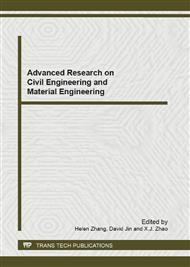[1]
luojixiang,Numerical simulations of interfacial debonding and matrix cracking in particle reinforced composites,Kunming:Kunming University of Science and Technology,2007. 26~30.
Google Scholar
[2]
Jiangyongqiu,composition material mechanics,xi an:traffic college at xian,1990. 5~11.
Google Scholar
[3]
Lewandowski J.J., Manoharan M., Hunt W.H. Fracture characteristics of an Al-Si-Mg model composite system. Materials Science & Engineering A: Structural Materials: Properties, Microstructure and Processing, 1993, A172(1-2): 63~69.
DOI: 10.1016/0921-5093(93)90426-f
Google Scholar
[4]
Llorca J., Gonzalaez C. Microstructural factors controlling the strength and ductility of fiber-reinforced metal-matrix composites. Journal of the Mechanics and Physics of Solids, 1998, 46(1): 1~28.
DOI: 10.1016/s0022-5096(97)00038-0
Google Scholar
[5]
Mummery P.M., Derby B., Scruby C.B. Acoustic emission from particulate-reinforced metal matrix composites. Acta Metallurgica et Materialia, 1993, 41(5): 1431~1445.
DOI: 10.1016/0956-7151(93)90252-n
Google Scholar
[6]
Brechet Y., Embury J.D., Tao S., et al. Damage initiation in metal matrix composites. Acta Metallurgica et Materialia, 1991, 39(8): 1781~1786.
DOI: 10.1016/0956-7151(91)90146-r
Google Scholar
[7]
Corbin S., Wilkinson D. The influence of fiber distribution on the mechanical response of a particulate metal matrix composites. Acta Metallurgica et Materialia, 1994, 42: 1311~1318.
DOI: 10.1016/0956-7151(94)90147-3
Google Scholar
[8]
Ghosh S., Ling Y., Majumdar B. Interfacial debonding analysis in multiple fiber reinforced composites. Mechanics of Materials, 2000, 32(10): 561~591.
DOI: 10.1016/s0167-6636(00)00030-2
Google Scholar
[9]
S. Li,S. Ghosh∗ Modeling interfacial debonding and matrix cracking in particle reinforced composites by the extendedVoronoi cell FEM. Finite elements in analysis and design, 2007(43): 397-410.
DOI: 10.1016/j.finel.2006.11.010
Google Scholar
[10]
luojixiang,Numerical simulations of interfacial debonding and matrix cracking in particle reinforced composites,Kunming:Kunming University of Science and Technology,2007. 32~38.
Google Scholar


